Garlic (Allium sativum) is a species in the onion genus. Garlic is native to Central Asia and northeastern Iran and has long been a common seasoning worldwide.
About 50 to 60 percent of garlic’s constituents are water, so it has higher dry matter content than other vegetables. Garlic contains about 30% carbohydrate, about 10% fat and about 7% protein. The organic material that makes this plant special is called Allicin and is made up of a series of sulfur compounds.
Garlic is effective in regulating blood circulation due to the presence of iodine and silica minerals and it has been recommended for a long time due to the presence of antibiotics in the treatment of bacterial diseases.
there are many cultivars of garlic in the world that are described below for the most famous ones.
Asian Tempest
This hard-neck garlic has a sharp taste to eat raw, but cooked it develops an intriguing sweet and tangy flavor akin to sweet pepper. Most people will not identify it as a ‘garlic’ flavor in a dish.
Usually there are between 5-7 nice sized plump cloves per bulb. Garlic cloves have relatively easy to remove semi-glossy wrappers. Cloves are a gorgeous deep purple streaked with gold.
Bogatyr
Bogatyr is an easy to grow garlic. The plant leaves are vigorous and upright and it can handle some neglect. The plant is shorter than the Porcelain garlics and there are Approximately 6-8 cloves per bulb. This big fat dark purple brown cloves have hard wrappers.
Chesnok Red
This cold-hardy variety comes from the Republic of Georgia and has a colorful skin with dark purple stripes. It matures later than most varieties, yielding small- to medium-sized bulbs with 9 to 20 cloves each. Chesnok Red is a good choice for roasting, as it retains its garlicky flavor well.
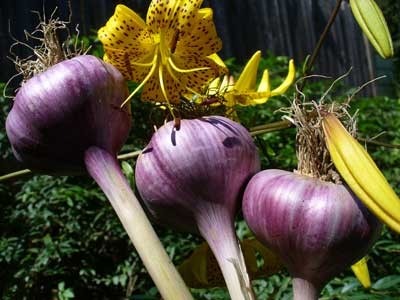
Georgian Crystal
The Supermodel of garlic; big, bold, and beautiful! Georgian Crystal is a hard-neck garlic and in the Porcelain family. Individual bulbs are large, with 5 to 8 large cloves each, and it’s often described as one of the best-tasting varieties, with a white-hot flavor.
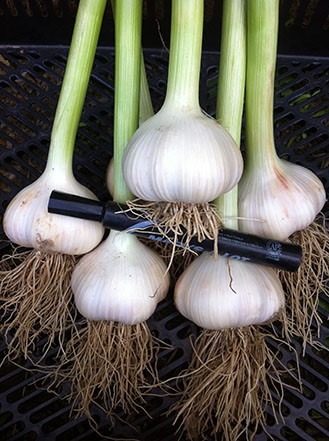
German Red
This variety features red stripes on its white outer skin and produces large bulbs with approximately 8 cloves each. It is rich and spicy in flavor, it’s a great choice for dehydrating or freezing, since it doesn’t store as well as other varieties.
Lorz Italian
A rich flavored soft-neck garlic with large long storing bulbs. This smooth bulb adds spicy flavor with medium heat to stir-fries, meats, roasted vegetables, tomato based sauces and other dishes. Cloves are normally arranged in a spiral pattern with larger cloves on the outside of the bulbs and smaller inner cloves. Soft-neck cloves are smaller than most hard-neck cloves .
Parvin
Parvin is a hard-neck garlic in the Porcelain family. It has a spicy and aromatic taste and large, symmetrical, beautiful and customer-friendly cloves. It is usually satisfied to the minimum ideal conditions and gives a good and coarse product. In proper storage conditions, it has a good shelf life of 2 to 6 months. If you want a spicy and aromatic garlic with symmetrical clove, it is advisable to use Parvin.
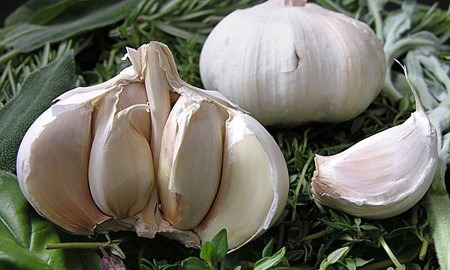
Red Rezen
A medium sized
garlic with 8-15 cloves per bulb, this variety is distinguished by its deep red
stripes. It is good in pesto because of its rich garlic flavor, which holds up
well without being very hot. Red Rezan is a hard-neck garlic in the Glazed Purple Stripe family.
Romanian Red
Romanian Red is a hard-neck garlic and in the Porcelain family . It is the perfect robust counterpart to ginger in hot Asian dishes and can hold its own with strong meats. Attractive large white bulbs that may have touches of pink usually contain 4-6 plump cloves.
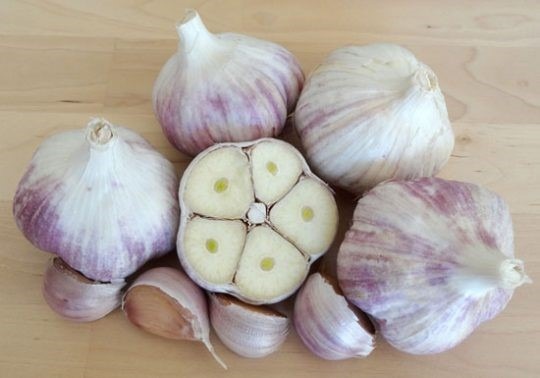
French Pink
Sweeter and milder in flavor than white varieties when cooked and hot when eaten raw, this variety is famous for its cloves’ pink blush. Plants produce 12 to 16 cloves per bulb and store very well.
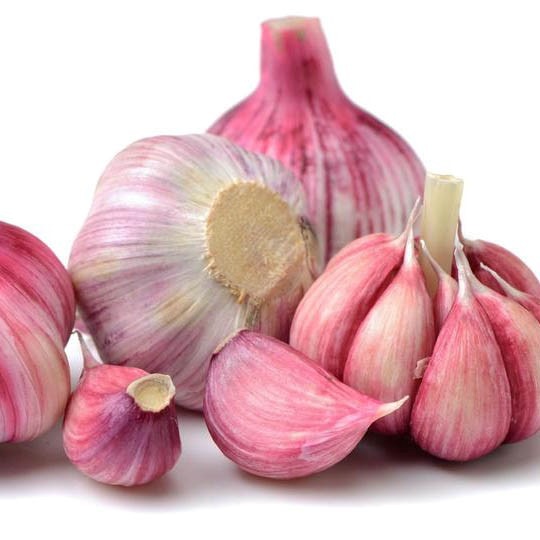
Properties of Garlic
- Very nutritious but low in calories
28 gram of garlic per person contains these nutrients:
Manganese: 23% of body requirement per day;
Vitamin B6: 17% of the body’s daily requirement;
Vitamin C: 15% of the body’s requirement per day;
Selenium: 6% of body requirement per day;
Fiber: 6 g
And proper amounts of calcium, copper, potassium, phosphorus, iron, vitamin B1
- Garlic for the treatment of cold
A large 12-week study found that daily consumption of garlic as a dietary supplement reduced the number of colds reported by those who ate garlic around 63 percent compared to the control group.
Another study has shown that high doses of garlic extract (2.56 g / day) can reduce the number of days with a cold or flu by 61%.
- Reduce blood pressure
Cardiovascular diseases like heart attack are the biggest killers in the world. Hypertension is one of the most important causes of these diseases. Human studies have shown that garlic as a dietary supplement has a significant effect on reducing blood pressure in people with hypertension.
- Prevention of Alzheimer’s Disease
Garlic contains antioxidants that protect us against cell damage and aging. Also it can reduce the risk of Alzheimer’s disease.
- It is a natural poultice for wound healing
One of the most important natural home remedies for garlic wounds. Garlic with its powerful antifungal and antibacterial properties helps heal almost all mild wounds. It’s always easy to work with.
- Garlic is also useful for treating hair leprosy
Garlic helps boost hair growth and make your hair softer. When garlic is combined with oils, it softens your hair and improves its overall texture, while also reducing the environmental damage to your hair and completely removing your hair leprosy.
- Garlic is Anticancer
Some studies have shown a direct link between increased garlic consumption and reduced risk of certain cancers such as colon, gastric, pancreatic, esophageal, and breast cancers.
The antibacterial properties of garlic enable it to prevent the formation and activation of carcinogens, reduce cancer cell proliferation, promote DNA regeneration, and cause cancer cell death.
A number of wonderful properties of garlic were mentioned. But it should be noted that the healing properties of garlic are much more than are not covered in this article.
Cultivation of Garlic in the world & Iran
| 2016 (ton) | Continent | Rank |
| 24383745 | Asia | 1 |
| 825187 | Europe | 2 |
| 703955 | Americas | 3 |
| 658236 | Africa | 4 |
| 1879 | Oceania | 5 |
Hamadan province of Iran is one of the most prone areas for garlic cultivation and large area is considered every year for cultivation of this crop.
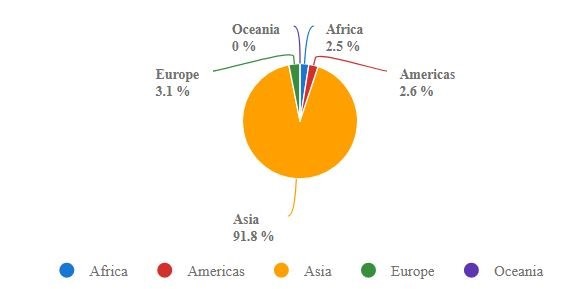
Every year, besides meeting the needs of the country, a large volume of garlic is exported to different countries of the world. According to the latest reports in 2018 about 3000 tons being exported to more than 10 countries such as Belgium, Qatar, Kuwait, Kazakhstan, Qatar and Azerbaijan etc. It is noteworthy that our company “kala Sepid Tarabar” as an international transportation & trading company has experienced and professional staff members in all matters related to any shipment (road – rail – sea-air and multi modal freight), so has always been able to serve the interests of its customers to purchase and export cargoes to all over the world as fast as possible as a strong advisor by choosing the best route and method of transport and positioning The global marketplace.
‘kala sepid tarabar’ as an international trading & transportation company in Iran focuses on the export of the agricultural and fresh fruit. Our experiences and resume reflect our quality of work and honesty.
As you know we also are exporters of high-quality white garlic. we have supplied and exported sorted garlic from high-grade farms of Hamedan in sizes of medium and big in mesh and bag packaging. The following videos relate to loading 21 tons per month of superfine white garlic for exporting to Turkey in December 2019 and January 2020. So far we have also exported garlic to Russia and CIS with the safest shipping methods.
